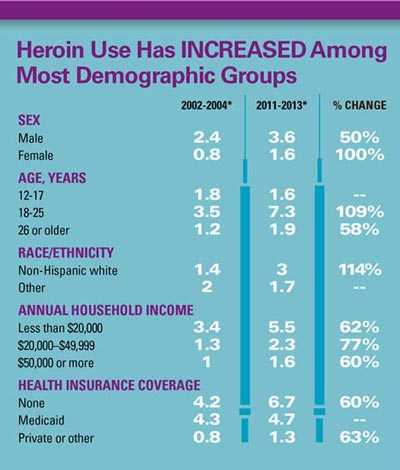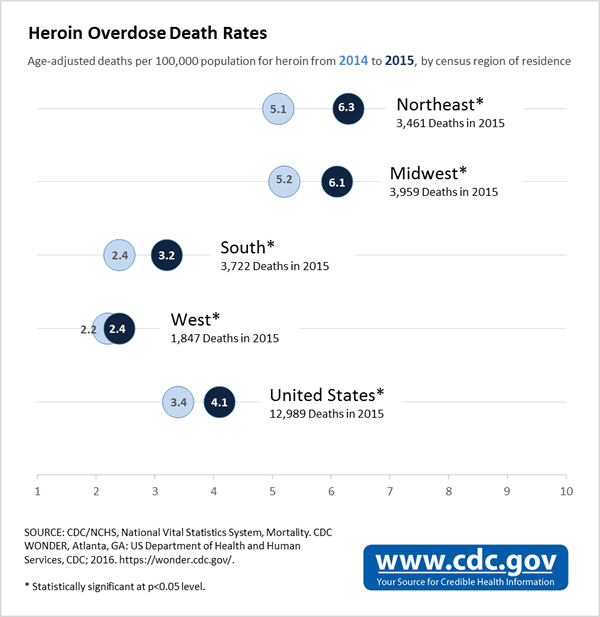Heroin Overdose Data
What is Heroin?
Heroin is a synthetic, highly addictive opioid that can produce intense feelings of euphoria.
Heroin Use
Heroin use has been increasing in recent years among men and women, most age groups, and all income levels. Some of the greatest increases have occurred in demographic groups with historically low rates of heroin use: women, the privately insured, and people with higher incomes. In particular, heroin use has more than doubled in the past decade among young adults aged 18 to 25 years.1
Heroin-Related Overdose Deaths
As heroin use has increased, so have heroin-related overdose deaths:
- Heroin-related overdose deaths have more than quadrupled since 2010.
- From 2014 to 2015, heroin overdose death rates increased by 20.6%, with nearly 13,000 people dying in 2015.
- In 2015, males aged 25-44 had the highest heroin death rate at 13.2 per 100,000, which was an increase of 22.2% from 2014.
 Risk Factors
Risk Factors
Past misuse of prescription opioids is the strongest risk factor for starting heroin use – especially among people who became dependent upon or abused prescription opioids in the past year.3 This indicates that the transition from prescription opioid non-medical use to heroin use may be part of the progression to addiction.
- More than nine in 10 people who used heroin also used at least one other drug.
- Among new heroin users, approximately three out of four report having abused prescription opioids prior to using heroin.
Increased availability, relatively low price (compared to prescription opioids), and high purity of heroin in the U.S. also have been identified as possible factors in the rising rate of heroin use. According to data from the U.S. Drug Enforcement Administration, the amounts of heroin confiscated each year at the southwest border of the United States were approximately ≤500 kg during 2000–2008. This amount quadrupled to 2,196 kg in 2013.

Age-adjusted death rates for heroin are displayed above by census region for 2014 to 2015. Rates increased in all regions—23.5% in the Northeast, 17.3% in the Midwest, 33.3% in the South, and 9.1% in the West.2 The heroin overdose death rate also increased in the United States overall—a statistically significant 20.6% increase from 2014 to 2015, with a total of 12,989 deaths in 2015.2 Deaths are classified using the International Classification of Diseases, Tenth Revision (ICD–10). Drug overdose deaths are identified using underlying cause-of-death codes X40–X44, X60–X64, X85, and Y10–Y14. Drug overdose deaths, as defined, that have heroin (T40.1) as a contributing cause. Age-adjusted death rates were calculated using the direct method and the 2000 standard population.2
References
- Centers for Disease Control and Prevention. Vital Signs: Today’s Heroin Epidemic – More People at Risk, Multiple Drugs Abused. MMWR 2015.
- Rudd RA, Seth P, David F, Scholl L. Increases in Drug and Opioid-Involved Overdose Deaths — United States, 2010–2015. MMWR Morb Mortal Wkly Rep. ePub: 16 December 2016. DOI: http://dx.doi.org/10.15585/mmwr.mm6550e1.
- Compton WM, Jones CM, and Baldwin GT. Understanding the Relationship between Prescription Opioid and Heroin Abuse. NEJM.
- Page last reviewed: January 26, 2017
- Page last updated: January 26, 2017
- Content source:
- Centers for Disease Control and Prevention,
- National Center for Injury Prevention and Control,
- Division of Unintentional Injury Prevention


 ShareCompartir
ShareCompartir
